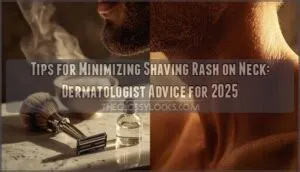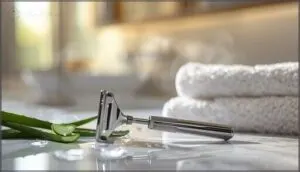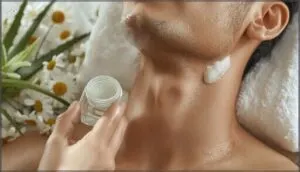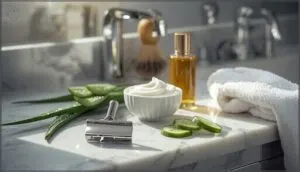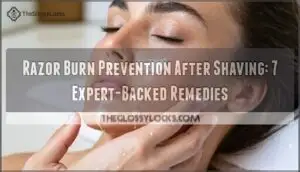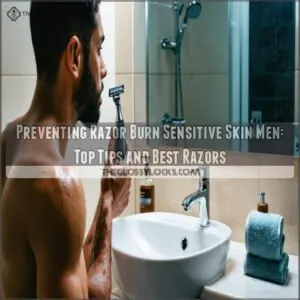This site is supported by our readers. We may earn a commission, at no cost to you, if you purchase through links.
That angry red rash creeping up your neck after a shave isn’t just annoying—it’s your skin waving a white flag. Most men think they’re doing everything right: good razor, decent cream, quick rinses. But here’s the catch: the neck’s skin is thinner and more sensitive than your face, with hair that grows in multiple directions like a cartographic nightmare. One wrong angle, a bit too much pressure, or skipping a key prep step, and you’re left looking like you lost a fight with a cheese grater.
The good news? Minimizing shaving rash on the neck doesn’t require expensive gadgets or dermatologist appointments. It’s about understanding what’s actually happening beneath the surface and adjusting your technique accordingly.
Table Of Contents
- Key Takeaways
- What Causes Shaving Rash on The Neck?
- Essential Pre-Shave Preparation Steps
- Best Shaving Techniques for The Neck
- Choosing The Right Razor and Blades
- Post-Shave Care to Prevent Rash
- Effective Treatments for Shaving Rash
- Tips for Preventing Future Shaving Rash
- Frequently Asked Questions (FAQs)
- Conclusion
Key Takeaways
- Your neck’s skin is thinner and has fewer oil glands than your face, making it more vulnerable to irritation—especially since neck hair grows in multiple directions that require grain-mapping before you shave.
- Dull blades and shaving against the grain are the primary culprits behind razor burn, causing microtrauma that invites bacterial infection (particularly Staphylococcus) and triggers inflammatory responses.
- Proper prep matters more than expensive products: warm water or steam for 60 seconds softens stubble, gentle exfoliation clears dead skin, and shaving with the grain using light pressure minimizes follicle damage by roughly 40%.
- Post-shave care should focus on immediate cooling (cold compress), fragrance-free moisturizers with aloe or vitamin E, and avoiding tight collars for at least 30 minutes to prevent friction-induced irritation.
What Causes Shaving Rash on The Neck?
Shaving rash on the neck isn’t just random irritation—it usually has a clear cause. If you’re wondering why your skin flares up after shaving, a few key culprits tend to be responsible. Here’s what you need to watch for.
Skin and Hair Follicle Irritation
Let’s talk about the real culprits behind neck irritation: Follicle inflammation and shaving microtrauma. When you shave, tiny cuts disrupt skin and hair follicles, opening the door for bacterial colonization—especially Staphylococcus. Your immune responses kick in, fueling redness and swelling.
Shaving creates tiny cuts that let bacteria like Staphylococcus invade hair follicles, triggering inflammation, redness, and swelling
This skin disruption is why shaving rash pops up so often, especially if your shaving and skin care routine needs a tune-up. This can lead to a case of infected hair follicles.
Dull Blades and Poor Razor Maintenance
You know that nagging sting after a rushed shave? Blame dull blades and poor razor maintenance. Blade sharpness matters—scraping with a blunt edge ramps up irritation and uneven cuts. Razor sanitation isn’t just hygiene; it’s a shield against infection. Keep these habits in check:
- Swap blades every 5–7 shaves
- Clean and dry razors
- Never share razors
Following proper blade replacement guidelines is vital for a smooth shave.
Shaving Against Hair Growth
Sharp blades are only half the battle—your shaving technique is the other. Shaving against hair growth patterns might promise a closer finish, but it’s a shortcut to razor burn and follicle damage.
The wrong shaving angles matter: tugging against the grain ramps up skin irritation factors. For smoother results, stick with the grain—your neck will thank you.
Inadequate Skin Preparation
If you skip Skin Cleansing or rush your Pre-Shave Routine, you’re inviting Shaving Rash to the party. Dirt, oil, and old skin cells linger—clogging pores and raising infection risk.
Hair Softening and Exfoliation Methods matter, too. Think of them as insurance for Skin Irritation Prevention.
Moisturizer Selection isn’t just pampering; it’s your neck’s shield against razor drama.
Sensitive Skin Factors
Sensitive Skin isn’t just a label—it’s a daily challenge. Your neck’s Skin Barrier is thinner, making Sensitive Types prone to Razor Burn and Shaving Rash. Hair Texture and Moisturizing Needs play a role, too.
Watch for these five Irritation Causes:
- Dryness
- Allergic reactions
- Eczema
- Excess oil
- Ingrown hairs
Shaving Rash Treatment starts with understanding your triggers.
Essential Pre-Shave Preparation Steps
Getting your neck ready before you shave makes all the difference. Small changes in your routine can help you avoid irritation and keep your skin feeling smooth.
Here’s what you’ll want to focus on before you pick up the razor.
Cleansing and Softening The Neck
Ever tried a warm towel wrap before shaving? It’s like rolling out the red carpet for your razor. Pre-shave cleansers sweep away dirt and oil, while hydration timing—three to five minutes—softens neck hair for smoother action.
Oils add a protective layer, reducing neck irritation and shaving rash. Smart PreShave Preparation sets the stage for excellent shaving technique and comfort.
Importance of Exfoliation
If you want smoother skin and fewer shaving rash flare-ups, exfoliating is your secret weapon. By gently buffing away dead cells, you unblock pores and even out skin tone—boosting collagen stimulation and product absorption. This simple step also softens fine lines, but reduces skin irritation and razor burn from poor shaving technique.
- Collagen stimulation and firmer skin
- Pore unblocking prevents breakouts
- Enhanced product absorption
Using Warm Water and Steam
Think of warm water and steam as your secret handshake with smooth skin—just sixty seconds of heat therapy softens beard hair, boosts skin hydration, and prepares pores for easy cleansing. This isn’t just comfort; it’s science-backed razor burn prevention.
Here’s how steam benefits stack up:
| Steam Benefits | Skin Hydration | Pore Cleansing |
|---|---|---|
| Softer Stubble | Less Dryness | Fewer Breakouts |
| Smoother Glide | Reduced Flakes | Clearer Complexion |
Choosing The Right Shaving Products
Choosing shaving products is like picking armor for your skin—one wrong move and you’re battling shaving rash. Go for Shaving Creams that hydrate, skip harsh alcohols, and match your Skin Types. Razor Blades must be sharp, not dull. Aftershave Balms should soothe, not sting. Scan Product Ingredients: avoid SLS, dyes, and strong fragrances.
- Hydrating Shaving Creams
- Sharp Razor Blades
- Alcohol-free Aftershave Balms
- Fragrance-free Shaving Products
Best Shaving Techniques for The Neck
Getting a smooth shave on your neck isn’t just about the right products—it’s all in the technique. Small changes in how you handle the razor can make a big difference for your skin.
Here’s what you’ll want to keep in mind next time you shave.
Shaving With The Grain
Mapping your neck’s grain direction is like reading a topographical map—miss a contour, and you risk razor burn or shaving rash.
Shaving with the grain preserves hair texture and skin tension, minimizing follicle trauma. Align your razor angle to the mapped growth for smoother results.
This simple shaving technique is one of the most effective shaving safety precautions and tips and tricks.
Using Gentle Pressure
Once you’ve mastered shaving with the grain, the next move is gentle pressure. Picture letting the razor glide—no bulldozing allowed.
Pressure technique training pays off here: you’ll notice less neck irritation, microtrauma reduction, and a lower erythema rate. Razor glide enhancement preserves your skin barrier, keeping shaving rash and razor burn at bay. It’s finesse, not force.
Avoiding Multiple Passes
Here’s where finesse meets restraint. More passes mean more neck irritation—each stroke risks microtrauma and shaving rash. You want fewer, gentler strokes, not a marathon.
Try these shaving tips:
- Limit pass frequency to one or two.
- Prioritize blade sharpness.
- Stretch skin for a flatter surface.
- Re-lather between passes for extra protection.
Optimal Shaving Speed and Direction
If you’ve limited passes, next up is speed and pressure. Go slow enough for control, but not so slow you linger—think steady, purposeful strokes. Grain mapping is your roadmap; follow hair growth, adjust angles, and keep skin taut. Here’s a quick cheat sheet:
| Shaving Tips and Tricks | Shaving Techniques | Razor Burn Treatment |
|---|---|---|
| Speed and pressure | Grain mapping | Cool compress |
| Stroke consistency | Angle adjustment | Aloe vera balm |
| Skin tautness | With-the-grain | Fragrance-free balm |
Choosing The Right Razor and Blades
Picking the right razor and blade goes a long way toward preventing those stubborn neck rashes. There’s more to it than just grabbing whatever’s in your bathroom cabinet. Here’s what you need to look for before your next shave.
Single Vs. Multi-Blade Razors
Ever wondered why your neck flares up after shaving? Razor Blade Comparison matters. Single-blade razors glide gently, causing less skin irritation and fewer razor bumps than multi-blade designs. For Shaving Safety, consider:
- Single-blade razors: less friction, fewer shaving rash episodes
- Multi-blade razors: closer shave, but higher risk of razor burn
- Razor Design Innovations: protective guards reduce irritation
Technique trumps blade count every time.
How Often to Change Blades
Regularly swapping out your razor blade is key for Shaving Safety and minimizing Shaving Rash. Dull Blades drag and irritate the neck, especially if you shave daily or have coarse hair. Sharpness Tests—like checking for tugging—help you spot when Blade Replacement is due.
Here’s a quick guide:
| Shaving Frequency | Blade Sharpness | Razor Maintenance |
|---|---|---|
| Daily | 3–5 shaves | Essential |
| Weekly | 5–7 shaves | Important |
| Coarse Hair | 3 shaves | Critical |
Proper Razor Storage and Hygiene
Let’s talk Razor Sanitizing and Blade Maintenance—because your neck deserves better than a bacteria buffet. Store your Razor Blade upright in a dry spot, away from bathroom humidity.
Weekly deep cleans and smart Storage Solutions slash Bacterial Control risks. Good Hygiene Practices keep Grooming and Hygiene on point, reducing Razor Burn and Shaving Rash while boosting your Personal Hygiene game.
Post-Shave Care to Prevent Rash
Once you’ve finished shaving, what you do next can make all the difference for your skin. The right post-shave routine helps keep irritation in check and aids healing.
Here are a few steps you’ll want to incorporate.
Applying Cold Compresses
Think cooling your skin is just a quick fix? Actually, Cold Therapy is a powerhouse for Razor Burn Relief. Right after shaving, a cold compress calms Skin Irritation, shrinks swelling, and slows down those fiery nerve signals. For Post-Shave Soothing, try:
- Wrap ice cubes in a towel
- Use cold gel packs
- Apply a soaked washcloth
- Avoid direct ice contact
Soothing Moisturizers and Balms
Why settle for sting and dryness in your post-shave routine? A shaving balm loaded with soothing balm ingredients—think aloe vera, vitamin E, and oat protein—delivers hydration impact that calms skin irritation and repairs micro-abrasions.
Sensitive skin benefits from alcohol-free benefits, while consumer preferences lean toward moisturizers that nourish, protect, and keep shaving rash at bay, all day long.
Fragrance-Free Products for Sensitive Skin
Ever wondered why fragrance-free products are leading the charge in market growth? For those with sensitive skin, these innovations tackle shaving rash and skin irritation head-on. By skipping synthetic scents and harsh additives, you get better skin hydration and fewer shaving problems.
Consumer preferences now favor transparency and hypoallergenic formulas, thanks to a regulatory environment demanding safer, more effective shaving solutions.
Avoiding Irritants After Shaving
Alcohol avoidance after shaving isn’t just a trend—it’s a major advantage for your neck’s comfort. Skip aftershaves with alcohol or strong fragrances; they fuel skin irritation and dryness.
Instead, choose shaving balms with aloe vera, witch hazel, or natural oils. Avoid pore-clogging ingredients and mechanical irritation. Your skin will thank you with fewer rashes and smoother healing.
Effective Treatments for Shaving Rash
Shaving rash on your neck can be stubborn, but there are solid ways to calm it down. If you’re looking to soothe irritation and speed up recovery, you’ve got a few reliable options. Here’s what you can try next.
Aloe Vera and Natural Remedies
When your neck’s itching and red post-shave, Aloe vera benefits stand out—its antiinflammatory and moisturizing action soothes skin irritation treatment fast.
For extra relief, Witch hazel uses and oatmeal baths ease redness, while almond oil locks in hydration.
If you’re experimenting, try tea tree dilution for antimicrobial support, but always patch test first to avoid unwanted surprises.
Over-the-Counter Creams
If Aloe vera isn’t cutting it, over-the-counter creams step in. Cream effectiveness hinges on smart choices—think hydrocortisone cream for quick skin irritation treatment, or barrier creams for stubborn dermatitis. Watch for side effects, especially with prolonged use. Market trends favor these cream ingredients:
- Aloe Vera
- Ceramides
- Shea Butter
- Hydrocortisone (0.5–1%)
- Fragrance-Free formulas
When to Use Antibiotic Ointments
If over-the-counter creams aren’t enough and you spot infection signs—think pus, tenderness, or white-heads—antibiotic ointments come into play. Stick to application protocols: twice daily, no longer than 10–15 days. Overuse ramps up resistance risks and skin irritation.
Clinical cautions matter; reserve these for confirmed dermatological conditions, not every shaving rash or inflammation you encounter.
Letting The Skin Heal
Once infection is ruled out, rest speeds healing—don’t rush back to the razor. Avoid re-shaving and keep your hands off; no scratching means less Skin Irritation and Prevention headaches.
Moisturize gently to support the Skin Barrier and Wound Healing. Observe recovery for a few days; in Dermatology, patience pays off, and mild Shaving Rash often fades without intervention.
Tips for Preventing Future Shaving Rash
Staying ahead of shaving rash means making a few smart changes to your routine. It’s not just about technique—it’s also about what you do before and after the razor.
Here are some practical ways to keep irritation at bay.
Establishing a Consistent Routine
Ever wonder why some folks dodge Shaving Rash while others can’t catch a break? Routine adherence benefits your skin more than luck ever could. For smoother results, try:
- Consistent product usage
- Routine customization tips for your skin type
- A steady shaving schedule impact
- Routine troubleshooting guide for issues
- Diligent PostShave Routine
Master your Skin Care Routine—your neck will thank you.
Avoiding Tight Collars Post-Shave
If you slip on a tight collar right after shaving, you’re courting collar friction and skin irritation. Give your neck a breather—fabric breathability matters. Looser fits, collar extenders, or waiting 30 minutes post-shave can make a world of difference for Shaving Rash prevention.
Here’s a quick glance:
| Collar Fit | Fabric Type | Extender Benefits |
|---|---|---|
| Tight | Synthetic | Minimal |
| Loose | Cotton | Moderate |
| Extended Fit | Linen | Maximum |
Adjusting Frequency of Shaving
Regularly tweaking your shaving routine can make all the difference. For most, ideal intervals mean shaving every other day—especially if your hair type is coarse or your skin sensitivity is high. Stretching gaps too far often invites razor bumps and ingrown hairs.
Dermatologist guidance? Adjust shaving habits to your skin’s response, not tradition, to keep Shaving Rash and Razor Burn at bay.
Recognizing When to Seek Medical Advice
Sometimes your neck speaks louder than you think—and ignoring its distress calls can escalate a simple shaving rash into a medical problem. Watch for these severe symptoms requiring medical evaluation:
- Infection Signs: Pus, swelling, fever, or spreading redness beyond the shave zone signal bacterial trouble needing prompt attention.
- Allergic Reactions: Persistent rash despite switching products may indicate contact dermatitis requiring patch testing.
- Emergency Care: Extensive blistering or chemical burns demand immediate professional intervention to prevent scarring.
Frequently Asked Questions (FAQs)
Can electric razors reduce neck shaving irritation?
Like a barber’s strop from yesteryear, modern electric razors with cooling technology can genuinely reduce neck irritation. Studies show nearly 30% fewer users experience razor burn compared to blade shavers, especially with proper pressure sensitivity and wet/dry techniques.
Does shaving direction matter for different neck areas?
Absolutely—your neck hair grows in multiple directions, often upward on the sides and downward near the jawline. Shaving with the grain in each zone cuts rash risk by roughly 40% compared to one-stroke-fits-all approaches.
How does neck skin differ from facial skin?
Your neck’s skin is thinner and has fewer sebaceous glands than your face, making its barrier function weaker.
That’s why razor burn and skin irritation develop more easily there during shaving.
Are there specific razors designed for neck shaving?
Yes, several specialty razors target this tricky area. The King C. Gillette Neck Razor features optimally spaced blades to reduce razor bumps, while NeatNeck’s finger-wearable design with its moisturizing strip offers enhanced control over contours.
Can diet or hydration affect shaving rash frequency?
What you eat matters more than you’d think. Adequate water intake and omega-rich foods strengthen your skin’s defenses, while processed foods and dehydration can spike irritation by nearly 45%, making prevention much harder.
Conclusion
Look, you don’t need a medicine cabinet overhaul or a weekly skincare ritual. Minimizing shaving rash on the neck comes down to three non-negotiables: sharp blades, proper prep, and shaving with the grain.
Your neck isn’t asking for flawlessness—it’s asking for respect. Treat it like the sensitive territory it is, ditch the rushed morning routine, and those angry red bumps will become a distant memory.
Sometimes the simplest adjustments deliver the biggest wins.

